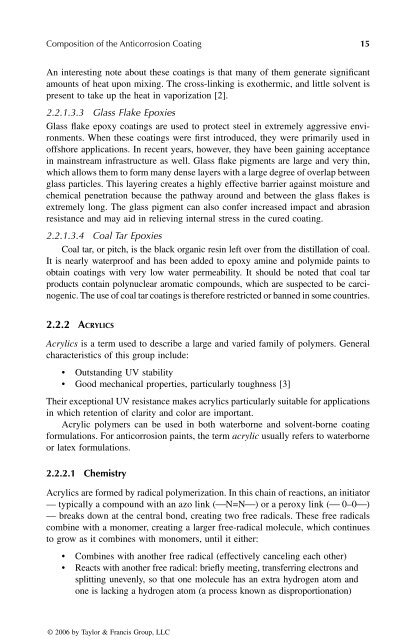© 2006 by Taylor & Francis Group, LLC
© 2006 by Taylor & Francis Group, LLC
© 2006 by Taylor & Francis Group, LLC
You also want an ePaper? Increase the reach of your titles
YUMPU automatically turns print PDFs into web optimized ePapers that Google loves.
Composition of the Anticorrosion Coating 15<br />
An interesting note about these coatings is that many of them generate significant<br />
amounts of heat upon mixing. The cross-linking is exothermic, and little solvent is<br />
present to take up the heat in vaporization [2].<br />
2.2.1.3.3 Glass Flake Epoxies<br />
Glass flake epoxy coatings are used to protect steel in extremely aggressive environments.<br />
When these coatings were first introduced, they were primarily used in<br />
offshore applications. In recent years, however, they have been gaining acceptance<br />
in mainstream infrastructure as well. Glass flake pigments are large and very thin,<br />
which allows them to form many dense layers with a large degree of overlap between<br />
glass particles. This layering creates a highly effective barrier against moisture and<br />
chemical penetration because the pathway around and between the glass flakes is<br />
extremely long. The glass pigment can also confer increased impact and abrasion<br />
resistance and may aid in relieving internal stress in the cured coating.<br />
2.2.1.3.4 Coal Tar Epoxies<br />
Coal tar, or pitch, is the black organic resin left over from the distillation of coal.<br />
It is nearly waterproof and has been added to epoxy amine and polymide paints to<br />
obtain coatings with very low water permeability. It should be noted that coal tar<br />
products contain polynuclear aromatic compounds, which are suspected to be carcinogenic.<br />
The use of coal tar coatings is therefore restricted or banned in some countries.<br />
2.2.2 ACRYLICS<br />
Acrylics is a term used to describe a large and varied family of polymers. General<br />
characteristics of this group include:<br />
• Outstanding UV stability<br />
• Good mechanical properties, particularly toughness [3]<br />
Their exceptional UV resistance makes acrylics particularly suitable for applications<br />
in which retention of clarity and color are important.<br />
Acrylic polymers can be used in both waterborne and solvent-borne coating<br />
formulations. For anticorrosion paints, the term acrylic usually refers to waterborne<br />
or latex formulations.<br />
2.2.2.1 Chemistry<br />
Acrylics are formed <strong>by</strong> radical polymerization. In this chain of reactions, an initiator<br />
— typically a compound with an azo link (⎯N=N⎯) or a peroxy link (⎯ 0–0⎯)<br />
— breaks down at the central bond, creating two free radicals. These free radicals<br />
combine with a monomer, creating a larger free-radical molecule, which continues<br />
to grow as it combines with monomers, until it either:<br />
• Combines with another free radical (effectively canceling each other)<br />
• Reacts with another free radical: briefly meeting, transferring electrons and<br />
splitting unevenly, so that one molecule has an extra hydrogen atom and<br />
one is lacking a hydrogen atom (a process known as disproportionation)<br />
<strong>©</strong> <strong>2006</strong> <strong>by</strong> <strong>Taylor</strong> & <strong>Francis</strong> <strong>Group</strong>, <strong>LLC</strong>
















